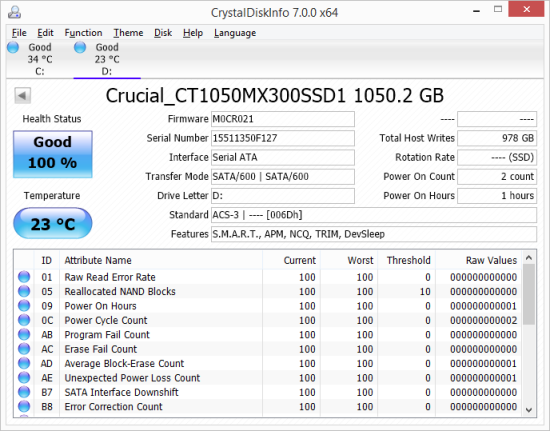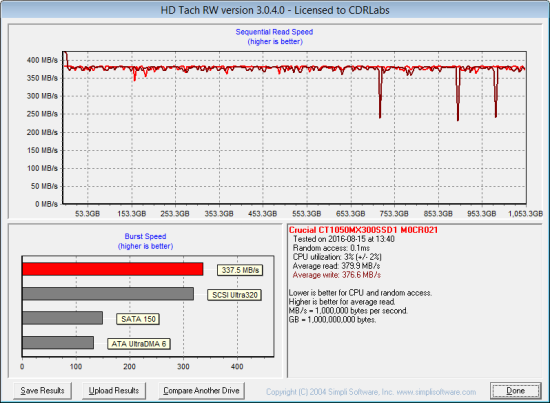TRIM Performance:
While SSD's offer many benefits, there are some downsides to using flash memory. One of the biggest issues people run into is performance degradation. Over time, an SSD will run out of fresh blocks and will have to write over data the file system has marked as deleted. This procedure is very complicated and can slow an SSD's write speeds considerably.
To fix this problem, most manufacturers have added TRIM support to their SSDs. The TRIM command allows an operating system, such as Windows 7, to tell an SSD which data blocks are no longer in use. Using this information, the drive pro-actively erases these blocks and adds them to the free block pool.

To test the MX300's TRIM and garbage collection functions, I first put the drive in a "dirty" state. I used Iometer to fill the entire drive and then ran a random write test for 30 minutes. This had little impact on the MX300's read speed. However, its average writing speed dropped to 48.3 MB/s.

Crucial MX300 - Dirty
To see how well the MX300 could recover, I let the computer sit for about 45 minutes and then reran the test. The drive wasn't able to reach the factory fresh performance shown in our earlier tests. However, its average write speed climbed up to 367.3 MB/s.

Crucial MX300 - After TRIM
Lastly, I used Crucial's Storage Executive software to perform a secure erase (aka sanitize) on the MX300. With the drive wiped clean, it had average read and write speeds of 379.9 MB/s and 376.6 MB/s, respectively.

Crucial MX300 - Secure Erased
Final Thoughts:
Like Crucial's previous MX series SSDs, the MX300 is an great choice for anyone looking to improve the performance of their existing desktop or notebook computer. The drive combines Marvell's 88SS1074B1 controller with Micron's new 3D TLC NAND to deliver good performance, enhanced features and a high level of endurance at a price that won't break the bank. In our sequential read and write tests, the 1TB version of the MX300 was able to read at speeds as high as 536 MB/s and write at speeds in excess of 514 MB/s. It also did surprisingly well in our random write tests, producing more than 80,000 IOPS at low queue depths.
Fast read and write speeds aren't the only things the MX300 has to offer. Along with thermal and power loss protection, TRIM support and active garbage collection, the drive features AES 256-bit full disk encryption and is compatible with both the TCG Opal and IEEE 1667 specifications. The MX300 also uses Dynamic Write Acceleration to enable faster saves and file transfers, and technologies like Data Defense and Redundant Array of Independent NAND (RAIN) to guard against corruption and protect your data. Last, but not least, the MX300 supports the SATA Device Sleep (DEVSLP) standard which extends the battery life of a device by reducing the drive's power consumption when it's not in use.
The MX300 is available now in 275GB, 525GB, 750GB and 1050GB capacities. Prices on Amazon.com currently range from $70 up to $260 for the 1TB (1050GB) version reviewed here. If you need more storage, a 2TB (2100GB) version of the MX300 is scheduled to ship later this year and is expected to cost about $550.

Highs:
- Available in 275GB, 525GB, 750GB and 1050GB capacities
- Good sequential and random read and write performance
- Performs equally well with compressible and incompressible data
- Large DRAM cache
- Dynamic Write Acceleration, Data Defense and RAIN technologies
- AES 256-bit full disk encryption
- TCG Opal and IEEE 1667 compliant
- DEVSLP power mode
- Supports TRIM, SMART and active garbage collection
- Thermal and power loss protection
- Ultra-slim form factor
- Includes mounting spacer for 9.5mm applications
- 3 year warranty
- Reasonably priced
Lows:
- Write speed drops when SLC cache is full

